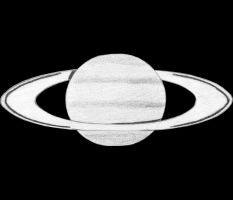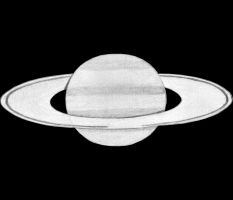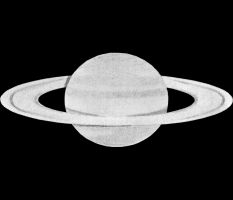
| SATURN |
|---|
Saturn is the sixth planet from the Sun. It is a gas giant (also known as a Jovian planet, after the planet Jupiter) and the second largest planet in the Solar System after Jupiter. It was named after the Roman god Saturnus, equated to the Greek Kronos (the Titan father of Zeus) and the Babylonian Ninurta. Saturn's symbol represents the god's sickle. The planet Saturn is primarily composed of hydrogen, with small proportions of helium and trace elements. The interior consists of a small core of rock and ice, surrounded by a thick layer of metallic hydrogen and a gaseous outer layer. The outer atmosphere is generally bland in appearance, although long-lived features can appear. Wind speeds on Saturn can reach 1,800 km/h; significantly faster than on Jupiter. Saturn has a planetary magnetic field that is intermediate in strength between Earth's and the more powerful field around Jupiter. Saturn has a prominent system of rings, consisting mostly of ice particles with a smaller amount of rocky debris and dust. There are at least 62 moons, with Titan being the largest. Titan is larger than the planet Mercury and is the only moon in the Solar System to possess a significant atmosphere. |
|
Saturn is probably best known for its system of planetary rings, which makes it the most visually remarkable object in the solar system. The rings of Saturn are a series of planetary rings that orbit the planet Saturn. They consist largely of ice, dust, and nitrous oxide. RINGS Galileo Galilei was the first person known to have reported observations of Saturn's rings, in 1610. With the telescope technology available, he could barely resolve them, and hypothesized that they were two moons on either side of the planet. In 1655, Christiaan Huygens was the first person to propose that there was a ring surrounding Saturn. There are several gaps between the rings, all of which are caused by orbital resonances between the tiny particles that comprise the rings, and one or more of Saturn's moons. SATELITES Saturn has a large number of moons. The precise figure is uncertain, as the orbiting chunks of ice in Saturn's rings are all technically moons, and it is difficult to draw a distinction between a large ring particle and a tiny moon. As of 2007, a total of 59 individual moons have been identified, plus 3 unconfirmed moons that could be small dust clumps in the rings. 48 moons have been named. Many of the moons are very small: out of 59, 33 are less than 10 km in diameter, and another 13 less than 50 km. Only seven of them are massive enough to have collapsed into spheroids under their own gravitation. These are compared with Earth's moon in the table below. Saturn's most noteworthy moon is Titan, the only moon in the solar system to have a dense atmosphere. |
|
SATURN |
||||
 |
 |
 |
||
Saturn 05.11.2005. |
Saturn 09.01.2006. |
Saturn 05.01.2007. |
||
VEDRAN VRHOVAC© 2006.-2007. |
